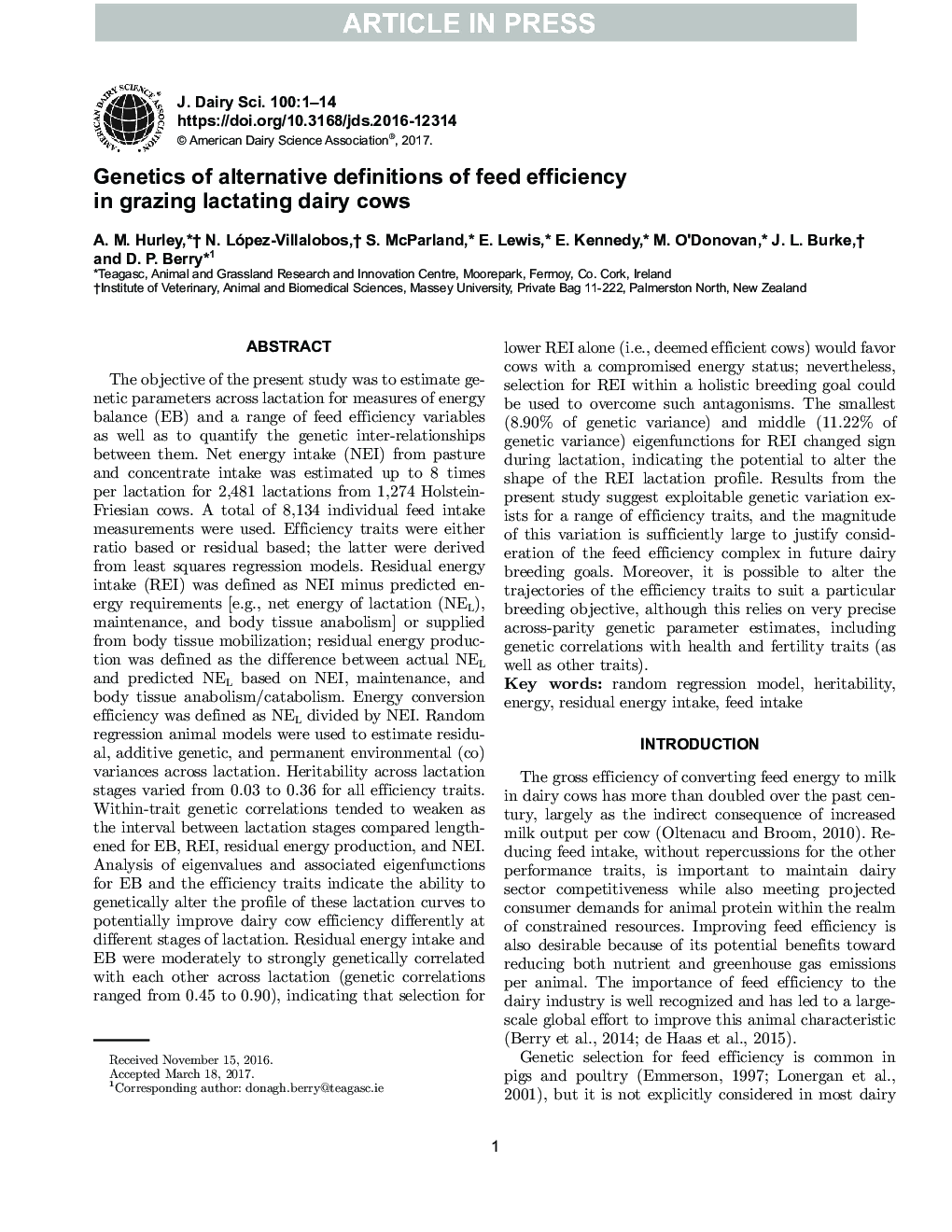| کد مقاله | کد نشریه | سال انتشار | مقاله انگلیسی | نسخه تمام متن |
|---|---|---|---|---|
| 5541757 | 1402510 | 2017 | 14 صفحه PDF | دانلود رایگان |
عنوان انگلیسی مقاله ISI
Genetics of alternative definitions of feed efficiency in grazing lactating dairy cows
ترجمه فارسی عنوان
ژنتیک تعاریف جایگزین بهره وری خوراک در گاو شیرده
دانلود مقاله + سفارش ترجمه
دانلود مقاله ISI انگلیسی
رایگان برای ایرانیان
کلمات کلیدی
مدل رگرسیون تصادفی وراثت پذیری، انرژی، مصرف انرژی پایدار، مصرف خوراک،
موضوعات مرتبط
علوم زیستی و بیوفناوری
علوم کشاورزی و بیولوژیک
علوم دامی و جانورشناسی
چکیده انگلیسی
The objective of the present study was to estimate genetic parameters across lactation for measures of energy balance (EB) and a range of feed efficiency variables as well as to quantify the genetic inter-relationships between them. Net energy intake (NEI) from pasture and concentrate intake was estimated up to 8 times per lactation for 2,481 lactations from 1,274 Holstein-Friesian cows. A total of 8,134 individual feed intake measurements were used. Efficiency traits were either ratio based or residual based; the latter were derived from least squares regression models. Residual energy intake (REI) was defined as NEI minus predicted energy requirements [e.g., net energy of lactation (NEL), maintenance, and body tissue anabolism] or supplied from body tissue mobilization; residual energy production was defined as the difference between actual NEL and predicted NEL based on NEI, maintenance, and body tissue anabolism/catabolism. Energy conversion efficiency was defined as NEL divided by NEI. Random regression animal models were used to estimate residual, additive genetic, and permanent environmental (co)variances across lactation. Heritability across lactation stages varied from 0.03 to 0.36 for all efficiency traits. Within-trait genetic correlations tended to weaken as the interval between lactation stages compared lengthened for EB, REI, residual energy production, and NEI. Analysis of eigenvalues and associated eigenfunctions for EB and the efficiency traits indicate the ability to genetically alter the profile of these lactation curves to potentially improve dairy cow efficiency differently at different stages of lactation. Residual energy intake and EB were moderately to strongly genetically correlated with each other across lactation (genetic correlations ranged from 0.45 to 0.90), indicating that selection for lower REI alone (i.e., deemed efficient cows) would favor cows with a compromised energy status; nevertheless, selection for REI within a holistic breeding goal could be used to overcome such antagonisms. The smallest (8.90% of genetic variance) and middle (11.22% of genetic variance) eigenfunctions for REI changed sign during lactation, indicating the potential to alter the shape of the REI lactation profile. Results from the present study suggest exploitable genetic variation exists for a range of efficiency traits, and the magnitude of this variation is sufficiently large to justify consideration of the feed efficiency complex in future dairy breeding goals. Moreover, it is possible to alter the trajectories of the efficiency traits to suit a particular breeding objective, although this relies on very precise across-parity genetic parameter estimates, including genetic correlations with health and fertility traits (as well as other traits).
ناشر
Database: Elsevier - ScienceDirect (ساینس دایرکت)
Journal: Journal of Dairy Science - Volume 100, Issue 7, July 2017, Pages 5501-5514
Journal: Journal of Dairy Science - Volume 100, Issue 7, July 2017, Pages 5501-5514
نویسندگان
A.M. Hurley, N. López-Villalobos, S. McParland, E. Lewis, E. Kennedy, M. O'Donovan, J.L. Burke, D.P. Berry,
